The Role of ABA Therapy in Building Positive Social Behaviors
October 29, 2025
How ABA Therapy Enhances Social Skills in Autism
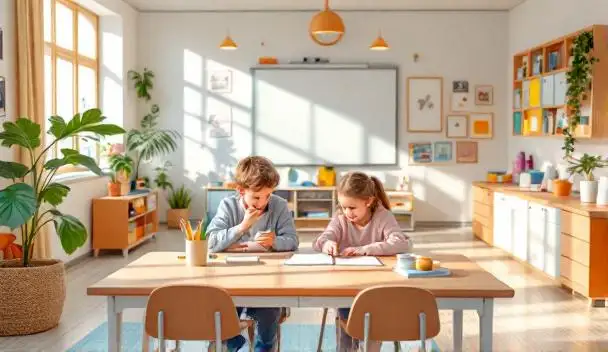
Understanding the Core of ABA Therapy
Applied Behavior Analysis (ABA) is an evidence-based therapeutic approach that plays a pivotal role in developing and strengthening positive social behaviors in children and individuals with autism. Rooted in the science of learning and behavior, ABA techniques are designed to systematically teach social skills, reinforce desired behaviors, and reduce challenging ones. These interventions are tailored to each individual, ensuring that the goals are specific, achievable, and meaningful. This article explores how ABA therapy contributes to social development, the techniques it employs, its effectiveness, and the benefits experienced by those it supports.
Foundations and Principles of ABA Therapy
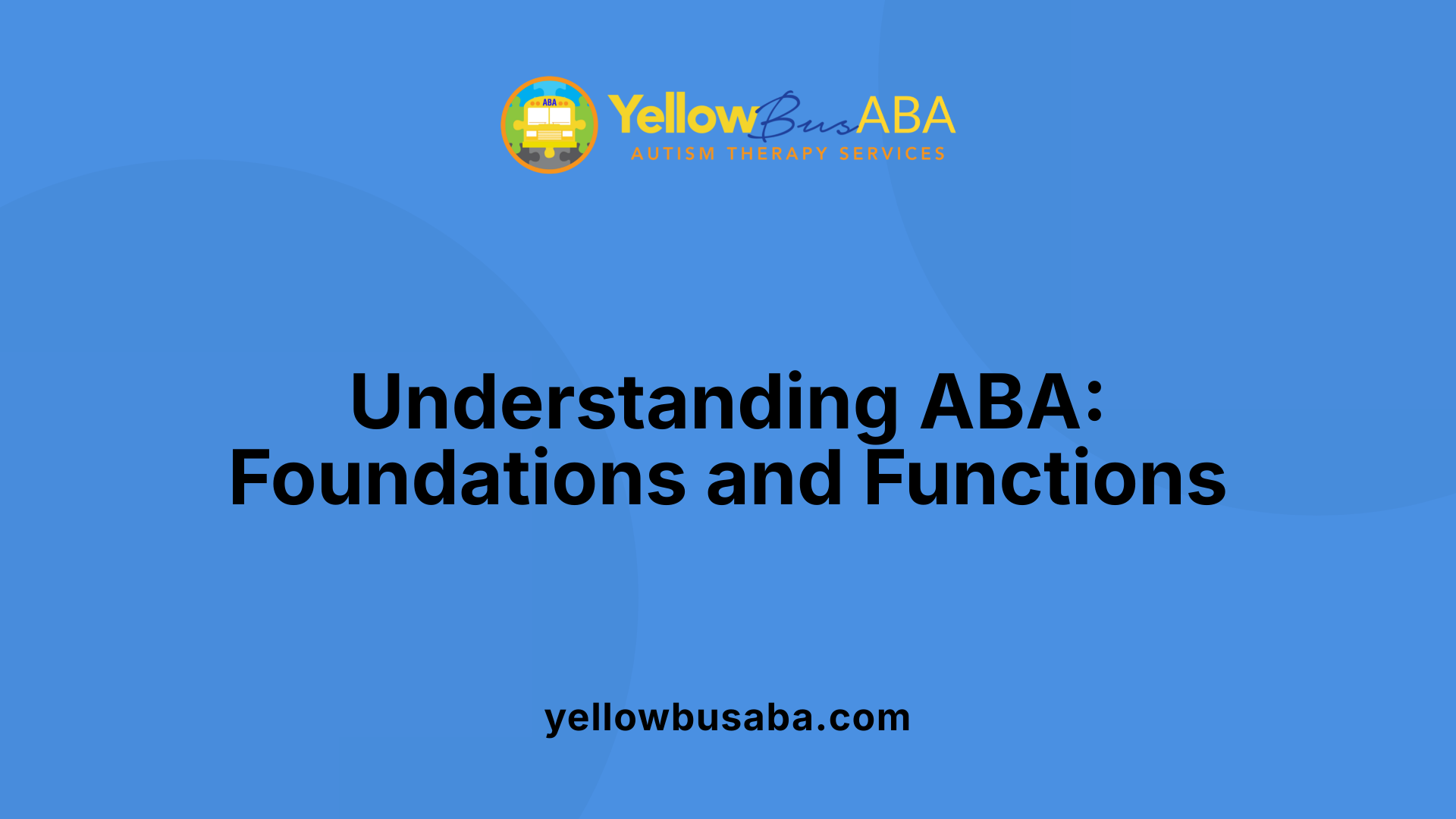
What is ABA therapy and how does it function?
Applied Behavior Analysis (ABA) is a well-established therapeutic approach rooted in the science of learning and behavior. It helps understand how behaviors are influenced by environmental factors. ABA employs behavior modification techniques to encourage positive behaviors—such as communication and social participation—and reduce challenging behaviors like aggression or tantrums.
This therapy uses strategies like positive reinforcement, where desirable behaviors are rewarded to promote repetition. It also incorporates structured methods such as discrete trial training (DTT), which breaks down skills into small, manageable steps, and natural environment teaching (NET), which involves practicing skills in real-life settings. By focusing on how behaviors are triggered and maintained, ABA creates tailored intervention plans that address each child's unique needs.
How does ABA therapy contribute to building social skills and positive behaviors?
ABA therapy plays a significant role in developing social skills by systematically teaching specific behaviors necessary for interaction and communication. Therapists design individualized programs that target crucial social abilities like making eye contact, greeting others, taking turns, and understanding social cues.
Techniques such as modeling, role-playing, and visual supports—like social stories and video modeling—are used to facilitate learning. These methods help children practice and reinforce skills consistently. For example, role-playing scenarios can teach turn-taking or how to respond to social cues effectively.
Interventions also incorporate activities like peer-mediated instruction, where children practice social interactions in group settings, promoting generalization of skills across different environments. Overall, ABA's structured approach helps children acquire, strengthen, and apply social skills, making social interactions more meaningful and less stressful.
Techniques and Methods Used in ABA Therapy
 ABA (Applied Behavior Analysis) employs a range of methods to improve social behaviors in children with autism. These techniques are designed to teach new skills, reinforce positive behaviors, and reduce problematic actions, all tailored to the individual child's needs.
ABA (Applied Behavior Analysis) employs a range of methods to improve social behaviors in children with autism. These techniques are designed to teach new skills, reinforce positive behaviors, and reduce problematic actions, all tailored to the individual child's needs.
One fundamental approach is discrete trial training (DTT). This highly structured method breaks down complex social skills into small, manageable steps, such as making eye contact or greeting others. Each step involves clear instructions, practice, and reinforcement to encourage mastery. DTT is effective for building foundational social skills through repetitive practice.
Natural Environment Teaching (NET) is another essential technique. Unlike DTT, NET uses real-life settings where children naturally encounter social situations. For example, during play or daily routines, children are guided to practice social skills like sharing, taking turns, or engaging in conversations. This method helps generalize skills across different environments and with various people.
Social stories and video modeling are powerful visual aids in ABA. Social stories are simple narratives that describe social rules and appropriate responses in specific situations, helping children learn about social cues and expectations. Video modeling involves showing children videos of peers or adults demonstrating desired behaviors. Both methods promote understanding and imitation of social actions.
Modeling and role-playing are interactive techniques that simulate social interactions. In modeling, therapists or peers demonstrate social behaviors for children to imitate. Role-playing allows children to act out social scenarios, such as greeting someone or asking for help, in a safe setting. These activities boost confidence and provide practical experience.
Visual supports and social scripts further enhance learning. Visual cues like pictures, charts, or social scripts (pre-written conversations) guide children during social exchanges. These tools help children anticipate social interactions, clarify social expectations, and respond appropriately.
Overall, ABA integrates these diverse techniques to develop skills like making eye contact, engaging in reciprocal conversations, understanding emotions, and participating in group activities. The combination of structured training, visual aids, and real-world practice ensures that children can apply social skills in everyday situations and improve their social functioning.
Addressing Challenges and Complex Social Skills
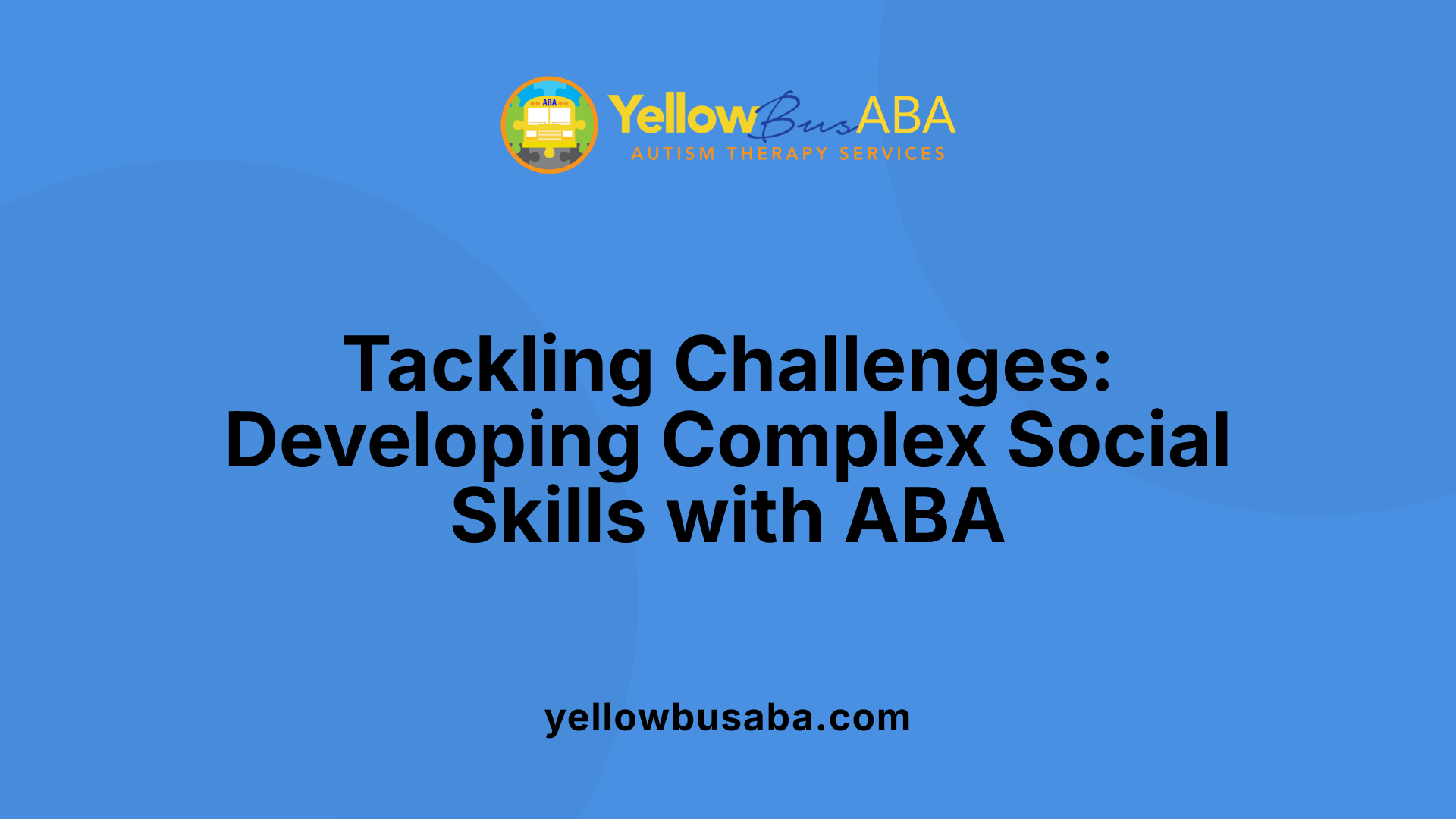
What complex social skills can ABA therapy target?
ABA therapy is effective at helping individuals develop a variety of complex social skills that are essential for meaningful interactions. These include interpreting social cues like facial expressions, body language, and tone of voice, which are vital for understanding others' emotions and intentions.
It also focuses on teaching emotional understanding and empathy, enabling individuals to recognize and respond appropriately to the feelings of others. This can involve activities such as role-playing and using visual supports like social stories or video modeling to teach these concepts.
Engaging in reciprocal interactions, such as taking turns during conversations or play, and developing the ability to build friendships are also focal points of ABA interventions. These skills help foster social connections and improve overall social competence.
How does ABA support individuals in managing challenging behaviors that interfere with socialization?
ABA techniques are tailored to address behaviors like aggression, tantrums, or withdrawal that can hinder social participation. By carefully analyzing the triggers for these behaviors, therapists can implement strategies that reduce their frequency and intensity.
For example, positive reinforcement might be used to encourage alternative, more appropriate responses, while functional behavioral assessments help identify underlying emotions or needs that trigger problematic behaviors.
ABA also incorporates teaching emotional regulation and social responses, helping individuals learn how to express their feelings constructively and manage their reactions. This not only decreases disruptive behaviors but also enhances their ability to engage socially in various settings.
Additional insights into developing social skills and behavior management
| Technique | Description | Goals |
|---|---|---|
| Discrete Trial Training (DTT) | Structured, step-by-step teaching method | Building foundational social skills like eye contact and turn-taking |
| Natural Environment Teaching (NET) | Teaching in real-life situations | Generalizing social skills across various settings |
| Social Stories | Visual and written social scenarios | Understanding social cues and appropriate responses |
| Video Modeling | Demonstrating behaviors through videos | Teaching complex social behaviors visually |
| Peer-Mediated Instruction | Using peers to facilitate social interaction | Encouraging spontaneous social engagement |
By combining these approaches, ABA therapy offers a comprehensive pathway to develop sophisticated social skills while effectively managing behaviors that could impede social growth.
Supporting development beyond therapy
Parents and caregivers play a crucial role in reinforcing social skills outside of structured sessions. Activities such as playdates, modeling appropriate behaviors, and using visual supports can significantly enhance the child's social development.
Overall, ABA's structured, individualized approach provides a pathway not only to improve social abilities but also to better manage behavioral challenges, creating a foundation for more meaningful social interactions and emotional understanding.
Building Generalization and Transfer of Skills

How does ABA ensure that social skills are generalized across different settings?
Applied Behavior Analysis (ABA) emphasizes the importance of skill transfer from therapy sessions to real-world situations. To achieve this, interventions are intentionally designed to promote generalization. This involves training children in a variety of environments, such as at home, school, and community venues, rather than only in clinical settings.
ABA techniques like Natural Environment Teaching (NET) are used to embed learning in everyday contexts where children naturally interact with others. Role-playing, social stories, and video modeling are also employed to mimic real-life social scenarios.
Furthermore, involving different people—peers, family members, teachers—in therapy sessions helps children learn to apply skills across various social partners. Consistent practice outside the formal therapy setting is crucial.
Family and caregiver involvement is vital in this process. Training parents and caregivers equips them to reinforce social skills at home, during outings, and in community settings. This continuous reinforcement helps solidify new behaviors and motivates children to use their skills across different environments.
What roles do families and caregivers play in supporting social skills development?
Families and caregivers are essential partners in ABA therapy. They serve as the primary environment for practicing new skills, providing ongoing reinforcement and support outside structured sessions.
Their participation involves several key activities:
- Facilitating opportunities for social interactions, such as arranging playdates or community activities.
- Modeling appropriate social behaviors and communication skills.
- Using visual supports like social stories to guide understanding of social cues.
- Reinforcing progress with praise or rewards, which encourages continued use of skills.
- Observing and reporting behaviors to therapists to help tailor interventions.
By actively engaging in the child’s learning process, families help ensure that social skills are maintained and effectively generalized across all facets of daily life. This collaboration creates a consistent environment where children feel supported to develop and practice their social abilities.
How does ABA facilitate generalization and involve families?
The comprehensive approach of ABA encourages generalization through multiple strategies, including training in natural settings, involving diverse social partners, and ongoing family participation.
Family involvement is not just supportive but central to the success of social skills development. With proper guidance, families can provide meaningful practice opportunities and ensure skills learned during therapy are applied consistently.
This combined effort maximizes the chances that children will develop functional, adaptable social skills that enhance their independence and quality of life.
| Aspect | Approach | Role of Family & Caregivers | Benefits |
|---|---|---|---|
| Skill Transfer | Natural Environment Teaching, role-playing | Active participation in therapy sessions, practicing at home | Increases likelihood of real-world application |
| Reinforcement & Modeling | Visual supports, social stories | Reinforcing behaviors and modeling appropriate responses | Strengthens learned behaviors |
| Community Integration | Group activities, social stories | Facilitating play and social opportunities | Promotes social awareness and independence |
Fostering generalization in social skills through these combined strategies ensures that children with autism can successfully navigate different settings and build meaningful relationships across their daily lives.
Benefits and Effectiveness of ABA in Social Development
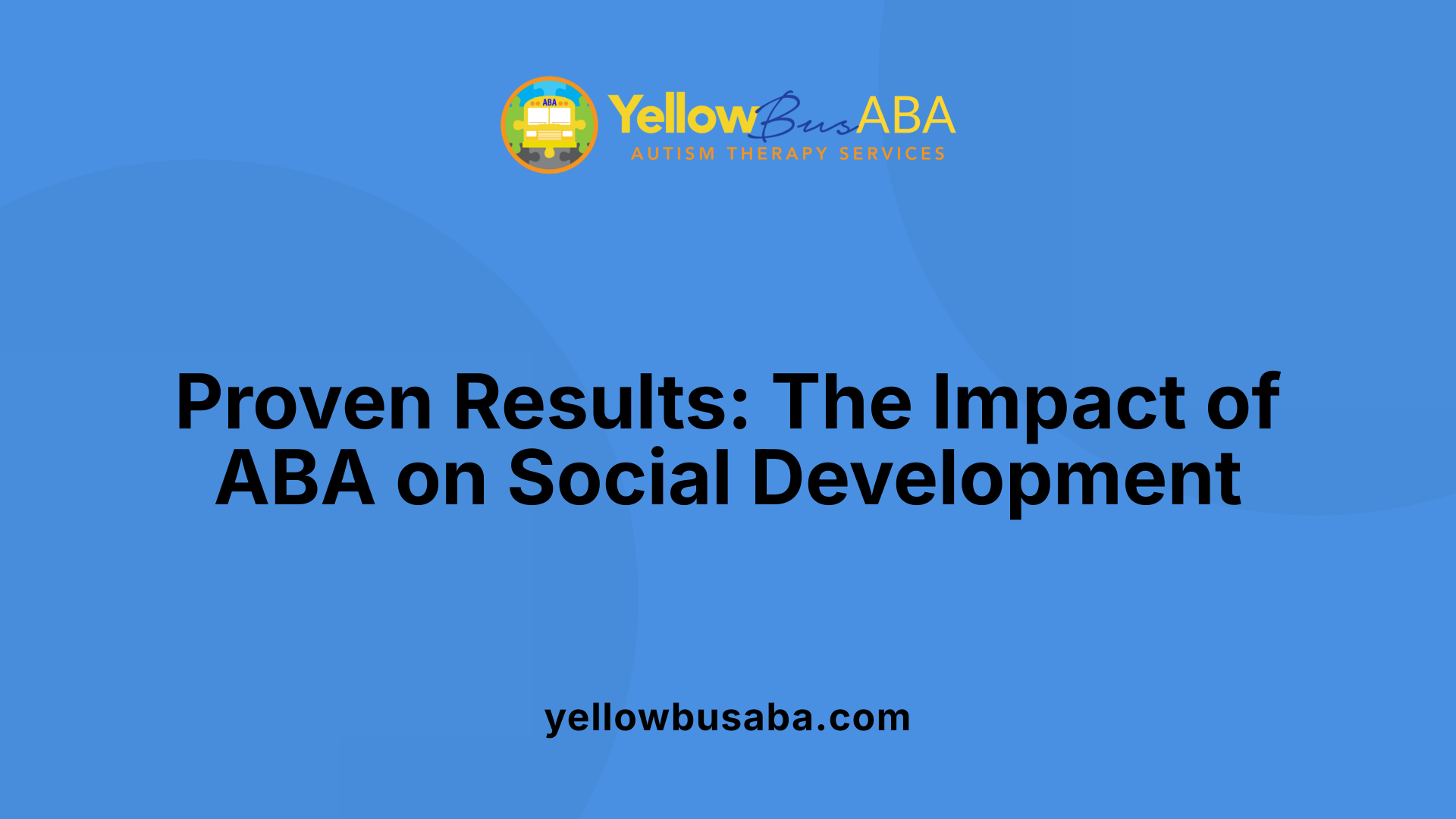
What evidence exists to support the effectiveness of ABA in building social behaviors?
Research provides robust support for the role of ABA in developing social skills for children with autism. Multiple studies have shown that ABA interventions lead to significant improvements in social and communicative abilities. For example, a recent study involving 60 boys aged 4 to 11 demonstrated that children who underwent ABA sessions over six weeks showed notable progress in their social interactions and language development.
The research also highlights that ABA reduces problematic behaviors such as separation anxiety and manipulative tendencies. These positive outcomes are backed by data analysis that confirms the therapy’s impact on daily living skills, emotional regulation, and social functioning.
Recognized worldwide as a scientifically supported approach, ABA is endorsed by organizations like the US Surgeon General and the American Psychological Association. Its effectiveness is attributed to its structured techniques, including reinforcement strategies, role-playing, and social stories, which help children generalize skills across various environments.
What are some specific social skills that children with autism can develop through ABA?
ABA therapy covers a broad spectrum of social skills tailored to each child's unique needs. Children typically learn to make eye contact and initiate interactions, which are foundational for meaningful communication.
They also develop the ability to interpret social cues such as body language, facial expressions, and tone of voice, enabling better understanding of others' emotions.
Reciprocal conversations and turn-taking are taught through activities like role-playing and peer interactions, fostering friendships and social connections. Enhancing verbal and non-verbal communication, including the use of substitute communication devices or sign language, is also a primary focus.
Furthermore, ABA helps children understand and respond to emotions and develop empathy by engaging in activities that promote emotional awareness and socio-emotional understanding.
Skill building extends to self-care, group participation, and problem-solving in social contexts, providing a comprehensive boost to their social competence.
| Social Skill Area | Techniques Used | Expected Outcomes |
|---|---|---|
| Eye Contact & Joint Attention | Discrete Trial Training, visual cues | Improved focus, initiating interactions |
| Understanding Emotions | Social stories, role-playing | Increased emotional awareness |
| Reciprocal Speech | Video modeling, peer-mediated instruction | Engagement in conversations, building friendships |
| Social Cues & Body Language | Natural Environment Teaching, modeling | Better interpretation of social signals |
| Empathy & Emotional Response | Group activities, activities promoting empathy | Enhanced emotional understanding |
Parents can support their children’s social development by creating opportunities for playdates, modeling appropriate social behaviors, and providing positive reinforcement for social efforts. Using visual supports like social stories and encouraging conversations at home complement the gains made through ABA.
How does ABA contribute to overall social and emotional growth?
ABA's structured, individualized approach helps children develop essential social skills that improve their ability to interact, communicate, and adapt to social environments. By reinforcing positive behaviors, decreasing problematic ones, and fostering understanding of social cues, ABA creates a foundation for meaningful social engagement.
The therapy not only enhances specific skills but also promotes emotional growth, such as empathy and emotional regulation, which are crucial for forming healthy relationships throughout life. It aims to generalize these skills across different contexts and with diverse people, ensuring lasting benefit beyond therapy sessions.
The Impact of ABA on Long-Term Social Success
How does ABA contribute to sustained social skills development?
Applied Behavior Analysis (ABA) relies on a structured and personalized approach that emphasizes consistent practice and reinforcement of social skills. By breaking down complex social behaviors into manageable steps, ABA helps children gradually build their abilities in a systematic way.
Parents, caregivers, and therapists work together to reinforce these skills across different settings, promoting generalization—meaning the child can use their skills not just during therapy sessions but also in real-world situations like school, play, and family gatherings.
Ongoing support is vital. Caregivers are encouraged to continue practicing and reinforcing skills outside formal sessions. This continuous reinforcement helps to embed social behaviors into daily routines, making them more natural and automatic over time.
Family involvement and real-life application of skills greatly enhance their longevity. As children become more proficient, these behaviors become integrated into their daily lives, fostering independence and social confidence that can last into adulthood.
What role does continuous assessment play in ABA’s effectiveness?
Regular assessment is a cornerstone of effective ABA therapy. It involves monitoring a child's progress to ensure they are acquiring the targeted social skills. These assessments help identify which strategies are working well and which may need adjustment.
With ongoing evaluation, therapists can set realistic, personalized goals that align with the child's evolving needs. This adaptive process ensures interventions stay relevant and effective as the child develops.
Moreover, continuous assessment allows for early identification of emerging challenges or progress, providing opportunities to modify techniques promptly. This dynamic approach supports sustained growth in social skills, helping children adapt to new environments and social demands.
Ultimately, consistent monitoring encourages a tailored, flexible therapy plan that maximizes positive outcomes and promotes long-term social success.
To explore further, search terms like 'Long-term social development and assessment in ABA' provide additional insights into how ongoing evaluation supports lasting social gains for children with autism.
| Aspect | Focus | Approach |
|---|---|---|
| Consistency | Reinforcing skills over time | Daily practice, family involvement |
| Personalization | Adapting goals as children grow | Regular progress reviews |
| Generalization | Applying skills across settings | Real-world practice |
| Ongoing Support | Ensuring long-term retention | Continued reinforcement & assessment |
This sustained focus on adaptability, reinforcement, and assessment underscores ABA's effectiveness in fostering enduring social competencies in children with autism.
Supporting Social Development Beyond Therapy
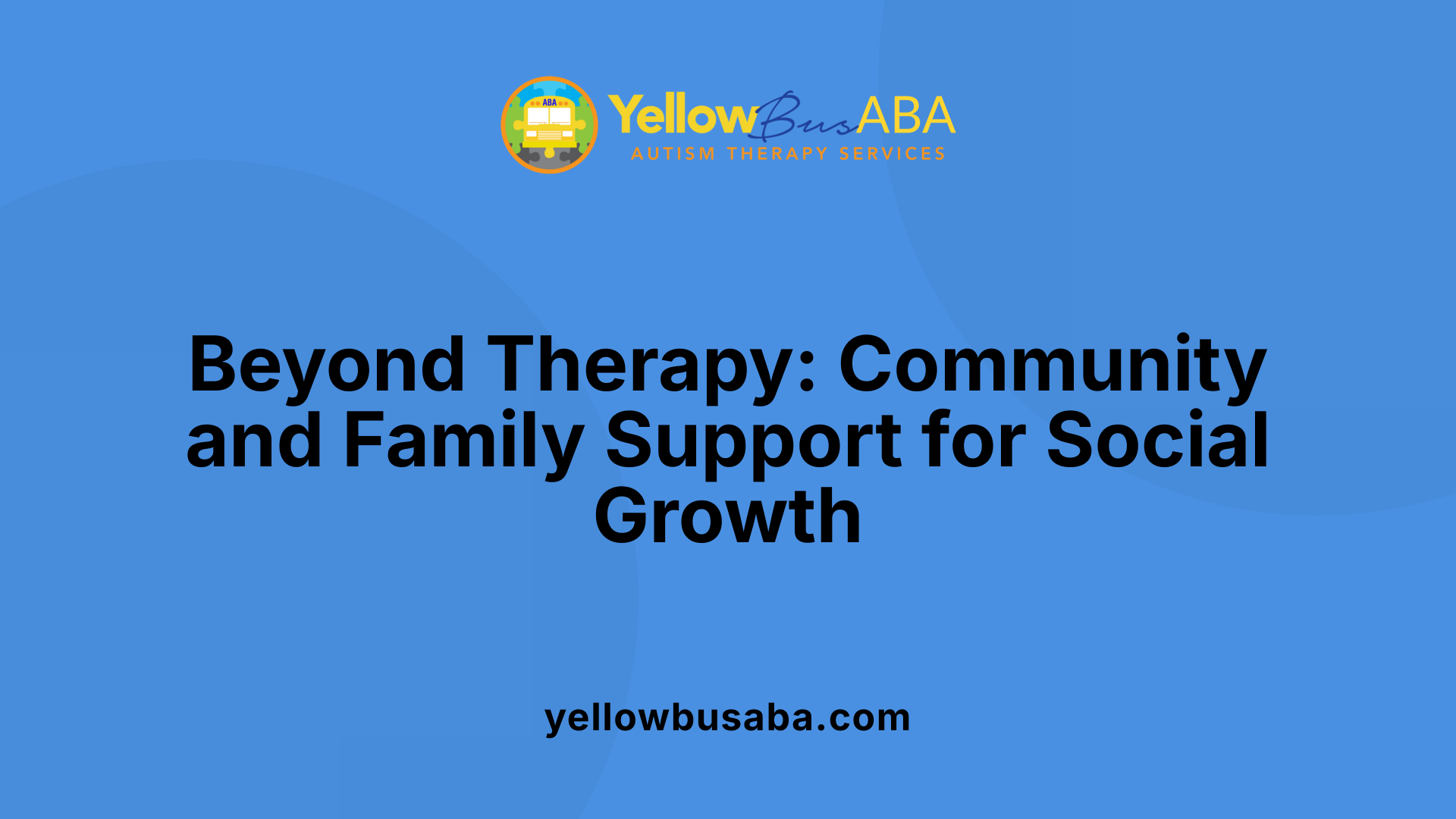
How can community programs support social skills learned in ABA?
Community involvement plays a vital role in reinforcing the social skills gained through ABA therapy. Inclusive activities such as local clubs, sports teams, and social groups offer children authentic environments to apply their skills. These settings encourage natural interactions with peers, helping children build friendships and confidence.
Participating in community programs allows children to practice social cues, communication, and cooperation in diverse scenarios. This helps to bridge the gap between structured therapy sessions and real-world situations. Moreover, exposure to different social contexts promotes adaptability and social integration.
Community programs also foster independence by providing opportunities for children to navigate social challenges independently. Supportive environments backed by trained staff further ensure that children receive the guidance they need while engaging in social activities.
How can parents foster social skills at home?
Parents are essential in extending social skill development outside formal therapy. Encouraging regular playdates with classmates or neighborhood children offers practical practice in a comfortable setting.
Modeling appropriate social behaviors, like greeting others, sharing, and taking turns, teaches children by example. Using visual supports and social stories helps children understand social expectations and navigate complex interactions.
Practicing conversations through role-playing allows children to develop verbal and non-verbal communication skills. Positive reinforcement—praising and rewarding children when they demonstrate social skills—motivates continued progress.
These strategies promote consistency, helping children generalize skills learned during ABA therapy into everyday life activities. When parents actively support social learning at home, it complements formal interventions, leading to more meaningful and lasting social development.
Activities to Promote Social Skills
| Activity | Description | Benefits |
|---|---|---|
| Playdates | Organized or casual meetups with peers | Encourages peer interaction and sharing |
| Role-playing | Simulated social scenarios | Builds confidence and social understanding |
| Visual supports | Social stories and cues | Clarifies social expectations |
| Video modeling | Watching videos of social skills in action | Reinforces correct behaviors |
| Peer-mediated instruction | Using peers to guide learning | Promotes natural social cues |
Supporting children beyond therapy involves community engagement, family efforts, and targeted activities. These combined strategies create a comprehensive approach to developing social skills, fostering independence and enriching their daily social experiences.
| Strategy | Focus Area | Expected Outcome |
|---|---|---|
| Community programs | Real-world practice | Improved social integration |
| Parental modeling | Daily interactions | Enhanced generalization of skills |
| Structured activities | Skill reinforcement | Better social competence |
Closing Thoughts on ABA and Social Growth
ABA therapy stands as a comprehensive, evidence-based approach to nurturing positive social behaviors in individuals with autism. By utilizing specific techniques such as modeling, role-playing, visual supports, and reinforcement, and emphasizing generalization and family involvement, ABA facilitates meaningful improvements in social skills. Its proven effectiveness underscores the importance of early, tailored intervention, enabling individuals to build relationships, communicate effectively, and engage fully in their communities, ultimately enhancing their quality of life.
References
- The effectiveness of applied behavior analysis program ...
- Applied Behavior Analysis (ABA)
- ABA Therapy for Social Skills: Building Connections
- How ABA Therapy Enhance Social Skills in Kids
- ABA Therapy for Enhancing Social Skills in Children with Autism
- Social Skills Training in Applied Behavior Analysis? ASD
- ABA Therapy for Social Skills: Building Connections
- ABA Therapy for Social Skills Development in Autism






